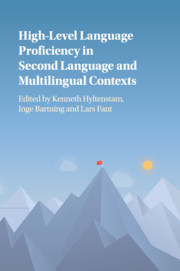Book contents
- High-Level Language Proficiency in Second Language and Multilingual Contexts
- High-Level Language Proficiency in Second Language and Multilingual Contexts
- Copyright page
- Contents
- Figures
- Tables
- Contributors
- Acknowledgements
- Introduction
- 1 Age Effects on Language Acquisition, Retention and Loss
- 2 The Last Barriers in High-Level L2 Speech
- 3 Discourse and Interaction in Highly Proficient L2 Users
- 4 Formulaic Language in Advanced Long-Residency L2 Speakers
- 5 Developing Lexical Complexity in Oral Production
- 6 Reading Comprehension in Advanced L2 Readers
- 7 Polyglotism
- 8 What’s the Target?
- Index
- References
2 - The Last Barriers in High-Level L2 Speech
Morphosyntax in Focus
Published online by Cambridge University Press: 07 June 2018
- High-Level Language Proficiency in Second Language and Multilingual Contexts
- High-Level Language Proficiency in Second Language and Multilingual Contexts
- Copyright page
- Contents
- Figures
- Tables
- Contributors
- Acknowledgements
- Introduction
- 1 Age Effects on Language Acquisition, Retention and Loss
- 2 The Last Barriers in High-Level L2 Speech
- 3 Discourse and Interaction in Highly Proficient L2 Users
- 4 Formulaic Language in Advanced Long-Residency L2 Speakers
- 5 Developing Lexical Complexity in Oral Production
- 6 Reading Comprehension in Advanced L2 Readers
- 7 Polyglotism
- 8 What’s the Target?
- Index
- References
Summary
Information
- Type
- Chapter
- Information
- Publisher: Cambridge University PressPrint publication year: 2018
